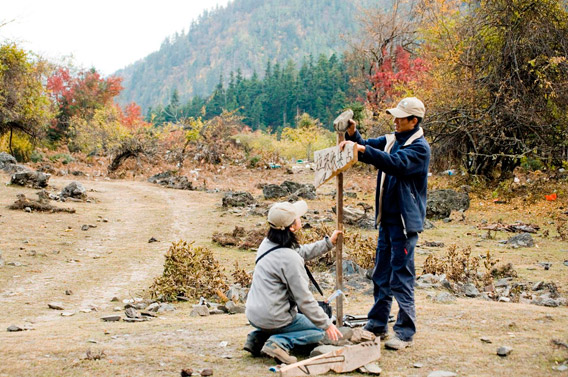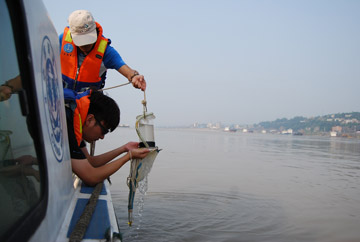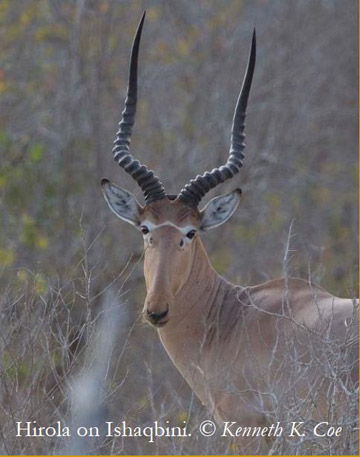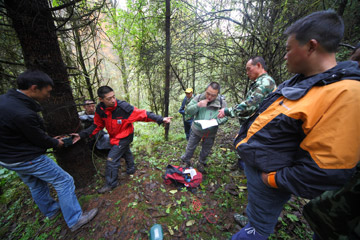An interview with the Nature Conservancy’s China Program.

TNC staff and volunteers repairing signage at Meili Snow Mountain National Park in northwest Yunnan. Community benefits and ecotourism are at the heart of TNC’s program to establish national parks in China. Photo by: Tang Ling.
Founded in 1951, The Nature Conservancy (TNC) works in more than 30 countries and
has projects in all 50 of the United States. The Conservancy has over one million
members, and has protected more than 119 million acres of wild-lands and 5,000 miles
of rivers worldwide. TNC has taken an active interest in China, the world’s most
populated nation, and in many important ways, a critical center of global development.
The following is an interview with multiple directors of The Nature Conservancy’s China
Program.
Mongabay: Please tell our readers about the background and history of The Nature
Conservancy’s (TNC) work in China.
 Zhang Shuang, the Director of the TNC China Program. |
Zhang Shuang, Director of TNC China
Program: Though TNC is a big international
organization, we started small in China,
in the critically important Northwest
corner of the province of Yunnan. We
were invited by the Yunnan provincial
government to help them complete a
regional conservation plan. That was in
1998. We still operate a number of
projects in Yunnan but now have also
expanded site work into Sichuan, Inner
Mongolia, and the Yangtze River Basin.
While the opportunities and need for addressing environmental challenges in China are
enormous, we still try to focus our work on select areas, where we can really have an
impact. This includes addressing climate change (through restoring forests and creating
adaptation strategies), introducing new models of protected areas while strengthening
existing conservation landscapes, and minimizing the
impact of hydropower and other development in the
Yangtze River Basin, China’s heartland.
I feel that many NGOs take on more than they can
realistically accomplish. Unfortunately, this often
makes their work ineffective. And this is why it is vital
that The Nature Conservancy China Program
step up in an inclusive (of local interests) and
measured pace.
Mongabay: Please tell our readers why China matters, especially in the arena of global
environmental efforts.
 Ma Jian, Deputy Director of TNC China Program. |
Yu Jie, Climate Change Policy Director of TNC China Program:
China’s significance is reflected by its impact on many global
economic development and resource consumption figures. Since
joining WTO in 2003, China has produced more of the world’s trading
commodities than any other nation. The changing lifestyle of the
Chinese people has enormous impact.
As a result, China now exceeds the US as the biggest energy
consumer in the world and is also now the largest GHGs or “green
house gases” emitter. China purchases raw materials globally,
mainly from other developing countries, then produces and sells
finished goods both domestically and to overseas markets.
Since China is the world’s largest consumer of coal, iron ore, copper, aluminum and
timber, where our country buys these materials, how it is processed in China, and how
Chinese manufacturing affects world resource markets, are the challenges that make
China matter.
Mongabay: It has been all too common for many in the conservation community to
simply label China as an “environmental bulldozer” in the battle to safeguard global
natural resources. What is TNC’s position on this line of thought?
Zhang Shuang, Director of TNC China
Program: China has rapidly growing resource demands. There’s no denying that. We have a
huge population that is focused on development and improving our quality of life. But we
at TNC see China—in many ways—more as an opportunity to improve global practices
around the environment. This is at the root of our non-confrontational, solutions-oriented
approach. Everything happens faster here, especially regarding regulations and
attitudes towards the environment. China is already becoming a global leader in fields
like green technology and ecological restoration, and is taking many noteworthy actions
to address climate change.
Of 26GW (gigawatts) global solar PV production, China manufactured over
80%. Ten percent of the products are consumed domestically and the rest to
supply a growing global market.
According to Global Wind Energy Council, China has led the new wind
energy installation capacity globally. The country’s new installation was
18GW in 2011, which counts for 2/5 of global wind energy production.
In 2009 alone, China planted 5.88 million hectares of forest, two and a half
times more trees every year than the rest of the world combined. This effort
represents the largest tree-planting program the world has ever seen.
Mongabay: Please describe some of the conservation highlights that the Conservancy
has fostered while working in China.
 “Yu Jie, Climate Change Policy Director of TNC China Program. |
Ma Jian, Deputy Director of TNC China Program:
We have been working with the Three Gorges Dam Corporation
and Chinese government agencies on a plan for sustainable
hydropower on the Yangtze River. If implemented, this plan will be
revolutionary by managing the river in an integrated way that
provides benefits to both the basin’s 400 million people and
hundreds of native fish species. Dams would be operated in ways
that mimic natural rivers flows that fish need to survive, while
producing more electricity and restoring downstream floodplain
wetlands. Last June, the Three Gorges Dam released excess water
flows to help trigger breeding in downstream carp species –
supporting China’s most important fishery species.
In Yunnan and Sichuan, we are also helping restore over 7000 hectares of natural
forests that will be certified to deliver benefits to local communities, wildlife, and climate
change by sequestering atmospheric carbon.
Mongabay: What main challenges does your group feel China faces in its efforts to work
for a healthy local environment? What areas could be improved? And what are some
of the positive steps that China has taken regarding environmentalism.
Ma Jian, Deputy Director of TNC China Program: Though it is growing rapidly, the environmental movement in China is really still in its
infancy. China is at the same tipping point that the U.S. was 50 years ago with
widespread pollution and environmental degradation. And like the U.S., China is
starting to take significant actions to address these problems. One notable area of
action is China’s pledge to reduce carbon intensity up to 45% of 2005 levels by 2020.
Another incredible goal is to restore 400,000 sq. km of forests and increase 1.3 billion
cubic meters of the standing volume in China by 2020! These are huge commitments
that require a great deal of support not only from the government but also from society
and organizations like TNC.
In one case, we worked with the government to develop a thorough biodiversity
database and set of conservation recommendations that later were key components in
the government’s National Biodiversity Conservation Strategy and Action Plan. It is
huge for an NGO to be referenced like this in a central government plan. We’re also
working with a wide range of agencies to introduce new conservation models to China
such as a modern national parks system and privately funded nature preserves called
land trust reserves. We’re also facilitating scientific exchanges between U.S. and
Chinese partners to improve capacity in areas like sustainable hydropower and wildlife
monitoring on the Yangtze, as well as analyzing the already occurring impacts of climate
change on people and nature. Though, currently, TNC has a very real impact on
Chinese conservation policy, it is still limited by rapid development in China. We still
have a long way to go.
Mongabay: Many of our readers may not realize that an increasing shortage of
freshwater in China poses one of China’s greatest environmental and economic
challenges. In a departure from the standard Nature Conservancy “land conservation
model,” a focus of TNC China has been the development and management of
watershed projects. Please describe how this came about, what progress has been
made, and what challenges remain.
 Collecting water samples on the Upper Yangtze Rare and Endemic Fish Nature Reserve near Chongqing. Promoting effective conservation is at this reserve is crucial for protecting the last habitat on the upper Yangtze for both fisheries species that communities depend on and rare species like the Yangtze sturgeon found no where else in the world. Photo by Yang Bo/TNC. |
Ma Jian, Deputy Director of TNC China Program: Actually, TNC’s mission is to conserve the lands and waters on which all life depends.
Our work on freshwater in China currently focuses on the Yangtze River basin, China’s
heartland. We are working with government partners to promote an integrated basin
management approach for the river’s resources: thinking about Yangtze as a whole
system rather than individual provinces
and cities acting unitarily without an
integrated plan. TNC has helped map the
basin’s biodiversity and defined priority
areas for conservation. In the face of
much unavoidable development, defining
these important areas is crucial for
sustaining a healthy and productive river
ecosystem. At the heart of our Yangtze
plan is the operation of dams on the
upper Yangtze to mimic natural flows that
will sustain downstream ecosystems and
help restore floodplain wetlands.
Mongabay: Bringing the concept of global conservation values full circle, TNC China’s
board of trustees recently fostered the development of the China Global Conservation
Fund. What is the primary purpose and intended scope of this philanthropic project?
Zhang Shuang, Director of TNC China
Program:
We established the fund to provide ways for Chinese philanthropists to contribute to
issues they care about globally. The fund was established last year through an
announcement from our Board of Director’s member, Jack Ma, and has an initial $15
million scope.
Mongabay: One of the Fund’s initial projects has been to help the conservation efforts of
the Hirola, a critically endangered antelope from East Africa. Please tell our readers a
little bit about this species, and why the Hirola became a priority for the China Global
Conservation Fund. What other conservation challenges is the China Global
Conservation Fund looking to support?
 The Critically Endangered hirola. |
Zhang Shuang, Director of TNC China
Program:
The fund itself was established after we took our China Board of Trustees members to
visit TNC project sites in Kenya last year. It was an eye-opening trip for them: seeing
firsthand the incredible wildlife in Kenya, as well as some of the conservation threats.
China’s wildlife consumption is often blamed for the escalating poaching in Africa. But
there we were with some of China’s most influential and wealthy individuals setting up a
fund to help protect Africa’s wildlife. That is why the Hirola Project was chosen first, it is
one of Africa’s—and the planet’s—most endangered species. The fund is now looking to
support conservation projects on nearly every continent. It is really inspiring.
And while these Chinese entrepreneurs (who comprise our Board of Directors) are
making significant contributions to efforts within China, in line with the country’s
economic trends, they too are becoming more globally oriented and thinking about
issues beyond our national borders. As their business interests expand abroad, they are
more connected to the global community. They want to contribute to sustainability and
protect nature not just in China but also in places they care about around the world.
This is very significant because they bring a tremendous
amount of new support for environmental initiatives and
a much needed expansion of global conservation
projects. This trend also adds a new dimension to
Chinese investment abroad. It is not purely development
oriented and profit driven. It shows they understand
promoting sustainability and conservation benefits for all
parties involved: business, nature, and communities.
These forward-thinking entrepreneurs are setting a very
compelling example for others. As positive outcomes
from projects supported by these pioneering
entrepreneurs occur, the process will expand
exponentially. Continuing rewards will encourage them to
do more and influence others to do the same. What we
are seeing now is only the beginning.
Mongabay: There are factions within global geopolitics that would argue the collective
weight of years of environmental degradation will work to greatly curtail (if not thwart)
China’s current spectacular growth to global prominence. Does your group see merit in
this premise? How can China best develop sound environmental policies to not only
maintain and further the prosperity of the Chinese people but also encourage the
adoption of these views on a global basis?
 Monitoring staff at the Motianling Land Trust Reserve in northern Sichuan setting up motion sensor cameras to collect information on the reserve’s rich wildlife including giant pandas, takin, and golden snub-nosed monkeys. Photo by Zhang Ming/TNC. |
Yu Jie, Climate Change Policy Director of TNC China Program: It is true that certain geo space has limited
our development capacity. Severe levels
of environmental degradation not only
affect development output, but also harm
public health. Issues like resource
extraction, energy consumption and
climate change also have a global impact.
Solutions for environment problems
should be based on the agreement of
sound environmental, economic, and
social policies. Currently, the biggest
barrier for natural conservation and
environment quality is China’s (growthcentric)
economic model.
The
government-driven high growth rate can leave little space for sound environment impact
assessment and affects the power balance during policy making and implementation.
Only when these domestic challenges are also sorted out will the planet benefit from a
healthier, sustainable, Chinese development. But this is the same challenge – the need
to balance development and sustainability—that most people in the developing and
developed world now face. Maybe we can learn from each other over time?